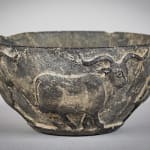Sumerian Stone Bowl, 3000 BCE - 2000 BCE
Stone
CB.2969
Further images
Sumer was an ancient civilization in southern Mesopotamia (modern Iraq) during the Chalcolithic and Early Bronze Ages. Although the historical records in the region do not go back much further...
Sumer was an ancient civilization in southern Mesopotamia (modern Iraq) during the Chalcolithic and Early Bronze Ages. Although the historical records in the region do not go back much further than ca. 2900 BCE, modern historians believe that Sumer was first settled between ca. 4500 and 4000 BCE by people who may or may not have spoken the Sumerian language. This stone bowl is thought to have been made sometime between 3000 BCE- 2000 BCE and depicts in carved relief what appears to be the figure of a bull, identified by the two horns (which in Mesopotamia represented the crescent moon). In ancient Mesopotamian mythology, the Bull of Heaven is also a mythical beast fought by the hero Gilgamesh.









